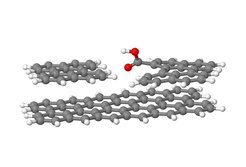Quantum Chemistry in Materials Sciences

Applying electronic structure theory in materials sciences is a challenging task, as molecular structures or an accurate description of the relevant details of the system are often unknown or poorly characterized. Hence, the task for theory is often to assess whether a hypothesis is plausible or which factors might influence a given property or phenomenon. While this seldomly demands for quantitative results as obtained by high-level ab-initio methods, it often requires regarding influences like structural diversity or the inclusion of solvent and environment effects. While theory can be used as a powerful tool to rationalize the connections between atomic and electronic structure and properties or mechanisms, relevant models can need to be devised in close cooperation with experimentalists. Only if the relevant questions are worked out together, meaningful "computational experiments" can be used to their full potential.
Examples for our work are projects focusing on processes and structures in heterogeneous catalysis:
J. W. Straten, P. Schleker, M. Krasowska, E. Veroutis, J. Granwehr, A. A. Auer, W. Hetaba, S. Becker, R. Schlögl, S. Heumann, Nitrogen‐Functionalized Hydrothermal Carbon Materials by Using Urotropine as the Nitrogen Precursor, Chem. Eur. J., 24, 12298, (2018).
P. Düngen, M. Greiner, K.-H. Böhm, I. Spanos, X. Huang, A. A. Auer, R. Schlögl, S. Heumann, Atomically dispersed vanadium oxides on multiwalled carbon nanotubes via atomic layer deposition: A multiparameter optimization,Journal of Vacuum Science & Technology A 36, 01A126 , DOI: 10.1116/1.5006783, (2018)
P. Kitschke, M. Walter, T. Rüffer, A. Seifert, F. Speck, T. Seyller, S. Spange, H. Lang, A.A. Auer, M. V. Kovalenko, M. Mehring,Porous Ge@C materials via twin polymerization of germanium(II) salicyl alcoholates for Li-ion batteries, Journal of Materials Chemistry A, 4, 7, 2705-2719 DOI: 10.1039/c5ta09891b, (2016).
Furthermore, we participated in a DFG-funded research consortium focussing on the twin polymerization ("organic - inorganic nanocomposites by twin polymerization" FOR 1497). The twin polymerization is technique for synthesizing hybrid organic/inorganic polymers with domain sizes in the nm range. A detailed analysis of possible reaction paths exhibits that the unique morphology of the resulting polymer is the result of a very fast formation of the organic phase that impedes separation of the inorganic phase. In our work, we also cooperatred on a scale bridging approach to simulate the twin polymerization process which is based on detailed quantum chemical calculations at the DFT level of theory in order to identify the most important reaction steps and estimate reaction rates.
P. Kitschke, A.-M. Preda,A. A. Auer,S. Scholz, T. Rüffer, H. Lang, M. Mehring, Spirocyclic tin salicyl alcoholates - a combined experimental and theoretical study on their structures, Sn-119 NMR chemical shifts and reactivity in thermally induced twin polymerization, Dalton Trans.,48, 220-230, DOI:10.1039/C8DT03695K, (2019).
A. A. Auer, G. Bistoni, P. Kitschke, M. Mehring, T. Ebert, S. Spange ,Electronic Structure Calculations and Experimental Studies on the Thermal Initiation of the Twin Polymerization Process, ChemPlusChem, 82, 1396, (2017).
P. Kempe, T. Löschner, A. A. Auer, A. Seifert, G. Cox, S. Spange,Thermally Induced Twin Polymerization of 4H-1,3,2-Benzodioxasilines, Chem. Eur. J., 20, 8040-8053. DOI: 10.1002/chem.201400038, (2014).
A. A. Auer, A. Richter, A. V. Berezkin, D. V. Guseva, S. Spange,Theoretical Study of Twin Polymerization - From Chemical Reactivity to Structure Formation, Macromolecular Theory and Simulations, 21, 615, (2012).
